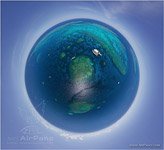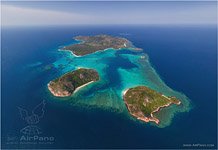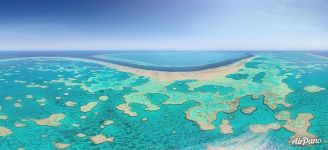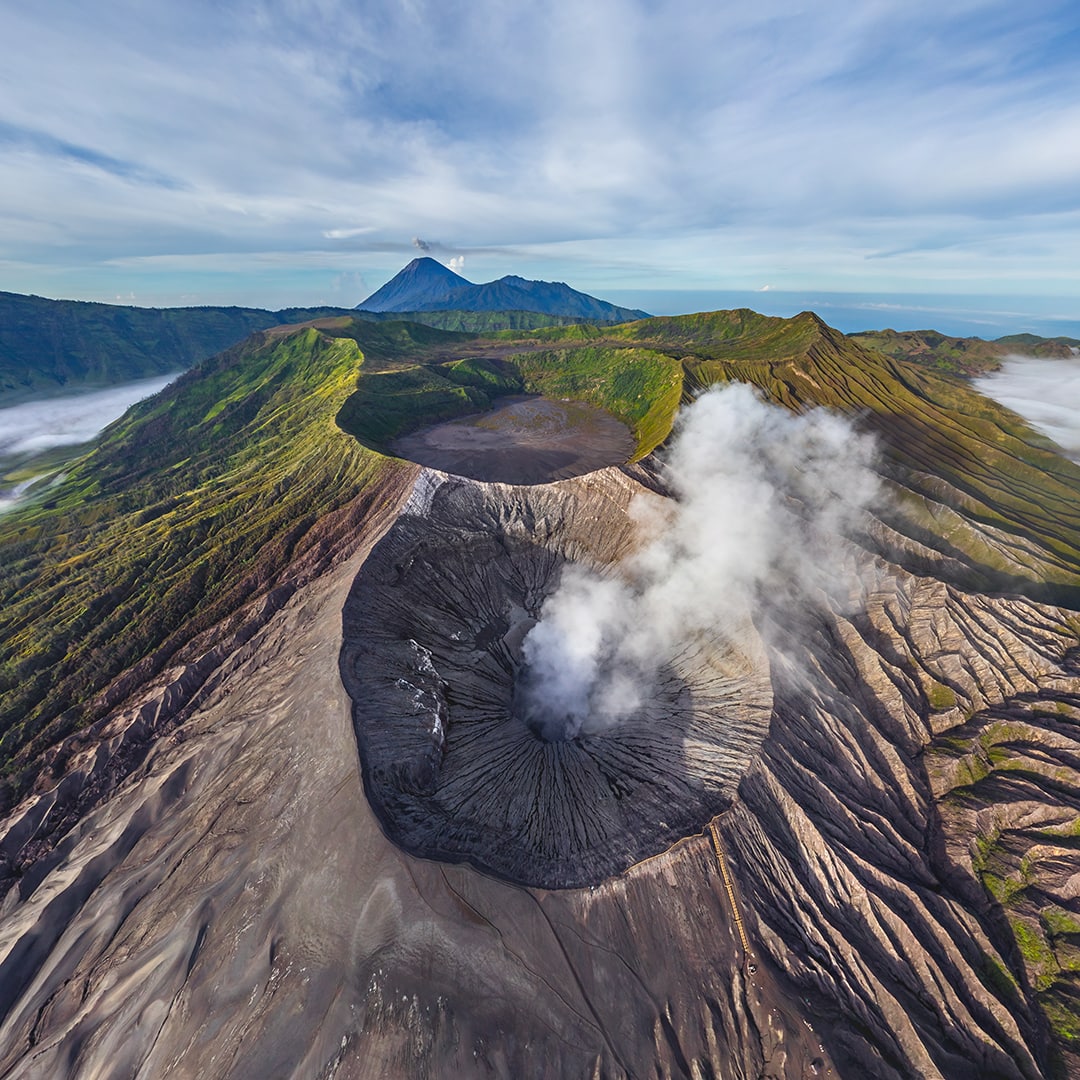The Great Barrier Reef, Australia
Strange as it may seem, I will start the story about my trip to Australia from Ethiopia.
Some believe that spending winter in Moscow is not the best idea, and so some people tend to escape winter's embrace to beaches with palms trees. Photographers feel cold as well and also dream of sunny destinations. So a trip to Ethiopia in early January looked like a good alternative to a standard downhill skiing.
Upon arrival to Addis Ababa the weather was great: +10 degrees Celsius outside the airport. Then we had to take another flight and to spend 8 hours in the car. Finally we were in the salt desert. It was suspiciously hot, obviously over 30 degrees Celsius, if not over 40. So I was waiting for the sunset. The sun finally set but the heat did not subside. The sweat was dripping down my face and I started wondering — What is this place? And they explained that it's "depression" — 140 meters below sea level. It was cool that time of the year, but in the summer temperature goes over 50 Celsius. There was an occasional breeze, but dust would accompany it. I was trying to cool down in our air-conditioned jeep.
But instead of cooling the A/C brought me nothing, but a cloud of dust. I was almost boiling under the sun. It turned out we had to spend 4 days there. I was saved by two things: dipping my T-shirt and a sunhat in water every hour, which gave me 20 minutes of coolness, and a bottle of cold Coca-Cola from a local grocery store. It was the most delicious drink I have ever tasted in my life!
So how did I end up in Australia? Finally, after arriving at a decent hotel with internet connection, I read the news and saw a headline: "Heat waves in Australia". The story was about +46 degrees in Sydney and +52 degrees in Melbourne. By that time I already got my tickets to the Great Barrier Reef (hereinafter GBR) — to the part of the fifth continent closest to the Equator.

That's when I realized what kind of winter I'm facing. This is why I thoroughly enjoyed Moscow cold weather during a weeklong break between Ethiopia and Australia.
This was summer time in Australia. Arriving at Cairns, I found out that even though my hotel faced the ocean, or rather the Coral Sea, the beach was empty. It turned out that summer is the dead season. The sea is so warm that the coastal water is filled with some harmful jellyfish and swimming is strictly prohibited.
The heat of +38 degrees with 100% humidity was almost unbearable. But car and room air conditioning, as opposed to Ethiopia, worked just fine. Taking my chances I've decided to go for a walk along the promenade towards restaurants. Of course I was sweating, but I didn't feel like I was suffocating while being locked up in a "submarine". Walking into any store brought a breath of fresh air. Plus Ethiopian hardiness somehow affected my body and it endured. I'll be getting ahead of myself by telling you that I froze near the open door while in a helicopter on the altitude of 1.5 kilometers.

I love to plan my trips ahead of time. Two weeks before going to Australia I sent letters to many helicopter companies that offered flights over the BBR. And the only thing I heard back from them was silence. I was expecting a prompt reply and I was very surprised when I didn't receive one. I decided that I will have to deal with it upon arrival. And just the day before my departure I finally received the first answer. The letter contained an apology and a link to the article. It appears that while there was a heat wave in the south, the north part of Australia was hit by days-long rainfall that flushed service provider's cell towers, and they sat on the bank without cell phones and Internet. This is why they received my email much later. But the important thing was that they did get it!
The town of Cairns is considered a "gateway" to the BBR. Coral islands in this area are situated close to the coast, and renowned diving points are only several hours away by a boat. Apparently there is no jellyfish far away in the sea.
But my task was to describe the beauty of BBR from above while in a helicopter.

The first flight was a disappointment. During the flight, despite all enthusiastic descriptions, I didn't discover anything even remotely interesting. The only thing I saw was a sandy island measuring 5x15 meters. It was a perfect place where you could feel like on a deserted island. However, the sight of helicopter standing still on the sand destroyed my exotic fantasy.
When we returned, the head of helicopter company invited me to his office and started talking about getting residence permit in Australia. I couldn't understand what was it exactly that he wanted from me. In the end he asked me directly if any of my friends wanted to get a residence permit by investing in the Australian economy, that is by buying his company. I promised to ask around. But so far no one has responded!
After reviewing the photos I realized that I do not feel any joy and satisfaction. And then I heard an email alert from my MacBook: a letter came from the company http://www.skysafari.com.au, located 80 kilometers to the north of Port Douglas. They finally restored their connection to the Internet! I immediately dialed the phone number, and the voice on the other end assured me that I can reach much more beautiful BBR reefs from Douglas, and I can also see Lizard Island as a bonus!
In the morning I was standing near small trailer in the open field with parked helicopter. This time we had a longer flight, but the pictures below us were more interesting: winding coral reefs lined up in chains, and Lizard Island, where we had to refuel, made a really big impression.

The sun was setting and we were on our way back when pilot suddenly steered towards the mountains, hovered over the waterfall and flew in the direction of a big cloud. When I asked him about it, he said that he wanted to show me a rainbow, which is formed around the helicopter shadow projected on the cloud.
There was a rainbow, but so weak that it could not be captured: my camera refused to focus on a cloud, and the moment was lost. After we landed, I went through the photos and was about to admit that I had to wrap up the BBR project when I noticed a beautiful photo on one of the trailer's walls: it was a picture of a small coral island shaped like a heart. When I asked if it was photoshoped, I was told that there is an actual reef like that 400 kilometers to the south of the shore and that it will take an hour to get there. I felt that my tour was incomplete without the "heart", and the next day I went to the town of Airlie Beach.
Staying at the beachfront hotel, I finally figured out how Australians cheat jellyfish: a fabulous pool was dug 10 meters away from the beach, where you can safely swim in the sea waters. The city was occupied by young people. As opposed to Cairns and Port Douglas there were at least five nightclubs open all night long, and small groups of girls in high heels strolled the main street from on club to another. They were accompanied by groups of boys, of course.
The next morning I flew to the Heart Reef. Along the way I saw several interesting islands, and one of them, Whitsunday Island, made a very strong impression. It is a big deserted island and a National Park. After white sugar sand and bent palm trees I suddenly spotted a stunning Whitsunday beach — a very long beach recognized as the most beautiful beach in Australia. The only way to get there is by boat or, like me, on a helicopter.

Adjacent to the beach is a picturesque inlet that can be described as a river bed filled with water from the sea during the high tide that brings all sorts of shockfish and different sharks, and during the low tide it shrinks down and becomes sandy beach.
I had to ask the pilot to slow down the helicopter in order to take pictures of this wonderful place. Another 40 minutes of flying and we arrived at the "heart". Yes, this reef was worth the couple of days it took to get to it. I was shotting it both from high and low altitude, using my telephoto lens until the pilot warned we were running out of fuel.
On the way back we landed on the Whitsunday beach. I had a sunbed and a bottle of champagne with me. I took my time sipping champagne from a glass while looking at the turquoise Coral Sea in the last rays of the setting sun. I wish I had someone by my side to share the delight of the "heart", sunset, and white sand.

It's amazing but at the moment I didn't feel heat at all, and I had absolutely no desire to return to my cold homeland.
Text and photography by Dmitry Moiseenko
And now we would like to give you some interesting facts about the Great Barrier Reef.
The Great Barrier Reef is located in the eastern part of Australia and it is one of the greatest wonders of nature. It stretches 2,500 kilometers along the coast and has a territory of 344,400 square kilometers. It is the largest coral ecosystem of our planet and the largest natural object formed by living organisms.
It's hard to believe, but during most of Australia's geological history its coastal waters have been so cold that corals couldn't exist there. It's explained by the fact that Australia has been a part of Antarctica for thousands of years. Australia drifted to tropical waters 65 million years ago. This event coincided with the rise of sea level, which created conditions that allowed coral reefs to grow near Australia's northeast coast.

For the most part the Barrier reef is less than 400,000 years old because the rest of the time the sea level was too low for corals to grow. Its youngest parts were formed in the last 200 years, and the most rapid growth occurred in the last 8,000 years during the rise of the World Ocean level.
The main part of the reef consists of more than 2,900 individual reefs of different sizes, ranging from 0.01 square kilometers to 100 square kilometers. The youngest reefs live on top of the old ones at an average depth of 15-20 meters. During low tide only a small part of the corals can be seen on the water surface, and in order to enjoy a more detailed picture you have to dive into the warm waters of the Pacific Ocean.
A shallow lagoon separates the coastline and the natural formation of 540 barriers consists of over 600 offshore islands that surround the reefs. It is a home to four hundred coral species of different colors: various shades of red, yellow, brown, purple, and even black. The Great Barrier Reef of Australia is a home to 1,500 species of ocean fish and 500 species of reef fish, including whale shark, the largest fish in the world. Waters around the reef are inhabited by several species of whales, dolphins and sea turtles, not to mention a great variety of shrimps, lobsters, and other small fauna. And finally, the reef provides shelter for more than 240 bird species. It is no wonder that this huge formation can be seen perfectly from the outer space.

Although Australia's aboriginal population started using the coral islands of the Great Barrier Reef about 40,000 years ago, for a very long time this natural monument has not been known to the Western civilization. In year 1770 famous explorer James Cook survived a shipwreck near the Great Barrier Reef. Many other ships that came here later faced the same fate. The first person to sail around the Barrier Reef in year 1815 was Charles Jeffries. Only in year 1980 — when most of the archipelago was thoroughly explored and mapped — this route became safe to travel.
Each year near two million tourists visit the Great Barrier Reef of Australia. However, despite the government's efforts to establish a set of restrictions aimed to protect coral reef ecosystem, its destruction is inevitable. In addition to devastation caused by humans (for example, oil spills from passing ships, or even tourists' suntan lotions dissolved in the water), the Great Barrier Reef is also susceptible to risks created by nature itself.

For example, the so-called fading occurs, which leads to large quantities of fast deaths of corals. It's caused by global warming that affects water temperature not only in Australia, but also around the world. The fragile balance of coral reefs is also greatly disrupted by tropical storms. And perhaps the worst enemy of the coral reefs is the crown-of-thorns starfish (Acanthaster planci) that sometime reaches up to a half-meter in size. They feed on coral polyps. In the 80s the echinoderms predators caused the most damage to the Great Barrier Reef in Australia.

According to the study published by the National Academy of Sciences of the United States in October 2012, since 1985 the Great Barrier Reef has lost over 50% of corals that form its structure! It is unfortunate that we were not able to shoot this panorama before, but even now the Great Barrier Reef, a UNESCO World Heritage Site, is one of the most impressive nature monuments not only in Australia, but also in the entire world. See it for yourself on our panoramas.
6 May 2013
Read more
Photogallery The Great Barrier Reef #15
The Great Barrier Reef #15
 Hook and Hardy Reef
Hook and Hardy Reef
 The Great Barrier Reef #17
The Great Barrier Reef #17
 The Great Barrier Reef #3
The Great Barrier Reef #3
 Heart Reef
Heart Reef
 The Great Barrier Reef #1
The Great Barrier Reef #1
 The Great Barrier Reef #29
The Great Barrier Reef #29
 The Great Barrier Reef #6
The Great Barrier Reef #6
 The Great Barrier Reef #37
The Great Barrier Reef #37
 The Great Barrier Reef #20
The Great Barrier Reef #20
 The Great Barrier Reef #9
The Great Barrier Reef #9
 The Great Barrier Reef #28
The Great Barrier Reef #28























